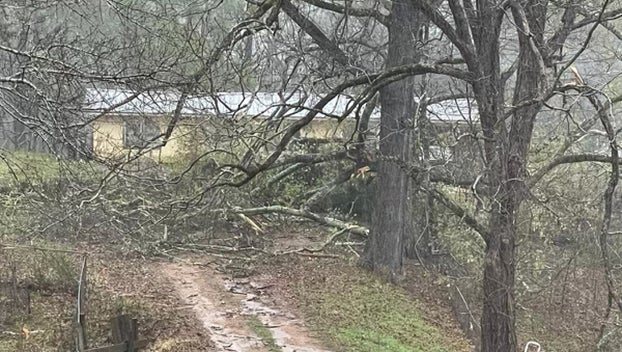Memphis braces for mighty Mississippi’s wrath
Published 11:23 am Saturday, May 7, 2011
MEMPHIS, Tenn. (AP) — Plastic bottles and tree limbs slowly drifted on the surface of the brown water near Henry Allen’s driveway, an ominous sign the flood was coming toward his home in a low-lying area in northeast Memphis.
As the crest of the Mississippi River crept south, rolling along the big river at a lazy pace, Allen decided it was time to flee. The water threatening his house was actually flowing over the banks of a tributary that feeds into the Mississippi, which is backed up with more water than it can handle.
Communities all along the banks of the Mississippi carefully watched the river rise, like a giant bathtub filling up with water.
“I hope I’ve got it worked out,” said Allen, who was getting ready to pack his red Ford F-150 pickup truck with TVs, microwaves and clothes and head for an aunt’s house Saturday. “What we leave behind, I don’t care about it. I hope it don’t get so bad that we have to cry about anything.”
His house is about 9 feet above the current water level, but the water has already inundated more than eight houses on his street, approaching the front windows of a few homes, nearly covering their mailboxes.
“We can’t do nothing about what Mother Nature kicks at us,” Allen said. “This is history making right here.”
Record river levels, some dating as far back as the 1920s, were expected to be broken in some parts along the river. In Memphis, the river was expected to crest at 48 feet on Wednesday, just shy of the 48.7-foot record from the devastating flood of 1937.
But the current crest in Memphis is already the second-highest for the city, eclipsing the previous 45.9-foot peak set during the historic flood of 1927.
There was also a chance residents might see rain Saturday, certainly an unwelcoming sight. But meteorologist Marlene Mickelson of the National Weather Service said the rainfall expected will be part of fast-moving storms, producing no more than a half-inch of moisture. The small amount won’t affect flooding, and the forecast is dry until Thursday.
In Louisiana, state officials warned residents that even if a key spillway northwest of Baton Rouge was opened, residents should expect floods comparable to those of 1973. Some of Louisiana’s most valuable farmland is expected to be inundated with water.
Louisiana Gov. Bobby Jindal said the Morganza spillway could be opened as soon as Thursday, but a decision has not been made. If it is opened, it could stay open for weeks.
A separate spillway northwest of New Orleans was to be opened Monday, helping ease the pressure on levees there.
The state’s Department of Children and Family Services increased shelter space near the areas expected to be flooded and is preparing for extended stays.
“You could see the spillway opened up for a few weeks, so it is going to be important that these shelters are going to be available to these folks beyond just the few days that is normally the case with a hurricane evacuation,” Jindal said.
To the north in Arkansas, a portion of Interstate 40 remained closed. The water there forced Jeffen Roddy to abandon her home in Biscoe, in the eastern part of the state. Then, the effects of the flooding followed Roddy to work.
She waits tables part-time at Craig’s Bros. Café, which feeds the truckers who have been rerouted.
“There’s no big trucks coming in and out of here,” Roddy said from an empty restaurant in De Valls Bluff on Friday. “We don’t have one customer.”
Since the interstate closed for 23 miles between Hazen and Brinkley on Thursday, people like Roddy who live or work in the middle have been stuck.
“It’s bad for business when the roads are closed,” said Roddy, 57, who is staying with a cousin on higher ground.
Because of levees and other flood defenses built over the years, engineers said it is unlikely any major metropolitan areas will be inundated as the water pushes downstream over the next week or two, but farms, small towns and even some urban areas could see extensive flooding.
“It’s going to be nasty,” said Bob Bea, a civil engineer at the University of California-Berkeley who investigated levee failures in New Orleans after Hurricane Katrina in 2005. How bad it gets depends on how well the flood-protection systems have been built and maintained, he said.
More than 4 million people live in 63 counties and parishes adjacent to the Mississippi and Atchafalaya rivers from Cairo, Illinois south to the Gulf of Mexico, down from 4.1 million in 2000, according to a census analysis by The Associated Press.
It’s about twice as many people who lived in the region before the 1927 and 1937 floods. In 1920, 2 million people lived in those counties and in 1930, 2.3 million lived there.
Most of the increased population comes in Memphis, where the county population has increased from 223,000 to nearly 1 million. Other big population increases were in Ascension, East Baton Rouge and Jefferson parishes in Louisiana, which combined increased by nearly 900,000 people and DeSoto County, Miss., which increased by 137,000 people.
The Coast Guard closed a five-mile stretch of the Mississippi to protect Caruthersville, Mo., and said barges could be banned for up to eight days. Then, later in the day, they reopened it after the National Weather Service lowered the projected crest at Caruthersville from 49.5 feet to 48.1 feet.
The fear was that the wake from big boats would push water over a floodwall and into the town of 6,700.
Coast Guard Capt. Michael Gardiner said river monitoring will continue and that navigation will be restricted when necessary.
Barges regularly move coal, grain, ore, gravel, auto parts and other vital products down the Mississippi. A single barge can carry as much material as 70 tractor-trailers, and some towboats can move 45 barges at once.
Lynn Muench, a vice president of the American Waterways Operators, said an eight-day shutdown would have a multimillion-dollar effect on the barge industry and slow the movement of many products.
“It’s just like if you took out every bridge going over the Mississippi, what that would mean to railroad and vehicle traffic?” Muench said. “You’re shutting down a major thoroughfare.”
She added: “The last thing we want is a levee to go, but we also want to keep moving.”
In Tennessee, local authorities were uncertain whether they had legal authority to order evacuations, and hoped the fliers would persuade people to leave. Bob Nations, director of emergency management for Shelby County, which includes Memphis, said there was still time to get out. The river is not expected to crest until Wednesday.
“This does not mean that water is at your doorstep,” Nations said of the door-to-door effort. “This means you are in a high-impact area.”
About 950 households in Memphis and about 135 other homes in Shelby County were getting the notices, Shelby County Division Fire Chief Joseph Rike said. Shelters were opened, and the fliers include a phone number to arrange transportation for people who need it.
Graceland, Elvis Presley’s home and one of the city’s best-known landmarks, is about a 20-minute drive from the river and in no danger of flooding, spokesman Kevin Kern said. “We’re on a hill, high and dry and open for business, and will stay open,” Kern said.
Water pooled at the lowest end of Beale Street, the thoroughfare synonymous with Mississippi blues, but it was about a half-mile from the street’s world-famous nightspots.
The main Memphis airport was not threatened, nor was FedEx, which has a sorting hub at the airport that handles up to 2 million packages per day.
Bea, the civil engineer, said he is concerned because some levees across the U.S. have been built with inferior dirt, or even sand, and have been poorly designed.
“The standards we use to build these things are on the horribly low side if you judge them by world criteria and conditions,” he said. “The breaches, as we learned in New Orleans, are the killers.”
How long the high water lingers, and how much damage it does to the earthen walls of the levees as it goes down, are crucial factors.
“The whole summer will have to be watched,” said J. David Rogers, a civil engineer at the Missouri University of Science and Technology.
Since the Great Mississippi Flood of 1927, a disaster that killed hundreds, Congress has made protecting the cities on the lower Mississippi a priority. The Army Corps of Engineers has spent $13 billion to fortify cities with floodwalls and carve out overflow basins and ponds — a departure from the “levees-only” strategy that led to the 1927 calamity.
The Corps also straightened out sections of the river that used to meander and pool perilously. As a result, the Mississippi flows into the Gulf of Mexico faster, and water presses against the levees for shorter periods.






